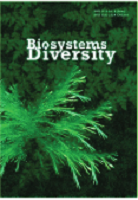Molecular revision of Rhagiini sensu lato (Coleoptera, Cerambycidae): Paraphyly, intricate evolution and novel taxonomy
Molecular revision of Rhagiini sensu lato (Coleoptera, Cerambycidae): Paraphyly, intricate evolution and novel taxonomy
Author(s): A. M. ZamorokaSubject(s): Physical Geopgraphy, Environmental Geography
Published by: Дніпропетровський національний університет імені Олеся Гончара
Keywords: longhorn beetles; Lepturinae; multigene analysis; phylogeny; homoplasy; systematics; new taxa; nomenclature;
Summary/Abstract: Due to classical taxonomy, the subfamily Lepturinae is divided into two large tribes Rhagiini s.l. and Lepturini s.l. However, this division is clearly artificial and does not correspond to the evolutionary relationships between the groups of genera with different morphologies that are part of these two tribes. However, there is a consensus among researchers supporting the monophyly of Lepturini s.l. while there is no such consensus for Rhagiini s.l. Over the past three decades, there have been several attempts to revise the tribe Rhagiini s.l. and divide it into smaller tribes. These attempts were somewhat successful based on larval and adult morphology. In general, eight tribes are distinguished within Rhagiini s.l. These include Teledapini, Xylosteini, Encyclopini, Oxymirini, Enoploderini, Rhamnusiini, Rhagiini and Sachalinobiini. However, the new system of Rhagiini s.l. is not always unambiguously accepted by different researchers, which causes discussions among experts. First of all, this is due to the fact that this system is only partially natural and far from fully reflects the phylogeny not only of Rhagiini s.l., but also of entire subfamily Lepturinae. In addition to the classical morphologic methods of studies, the use of the modern molecular phylogenetic methods opens up wide prospects for solving this puzzle. However, there have been very few such studies. Moreover, all of them were based on the use of only one gene. In this study, I used a general time-reversible (GTR) model of sequence evolution based on three mitochondrial (12S rRNA, 16S rRNA, COI) and two nuclear (18S rRNA, 28S rRNA) genes. My analysis yielded a well-resolved phylogenetic maximum likelihood tree, which clearly demonstrates the paraphyly of Rhagiini s.l. It consists of at least three clades representing different and distantly related evolutionary branches: 1) PaRh, 2) OSaXyR-SEP, 3) GAC. The extant Rhagiini s.l. are mostly heterogeneous relict groups with an intricate evolutionary and phylogeographic history. Most of these groups are represented by one or very few species, often isolated geographically on different continents. In particular, numerous cases of parallel and convergent evolution and homoplasy, a chimeric combination of plesiomorphic and apomorphic morphological characters, were found in all clades. Therefore, the evolutionary "tree" of Rhagiini s.l. is more like a "bush" with numerous relict branches. Finally, I proposed a new taxonomic model of Rhagiini s.l., which is the most consistent with their natural phylogeny, with new developments in nomenclature.
Journal: Biosystems Diversity
- Issue Year: 30/2022
- Issue No: 3
- Page Range: 295-309
- Page Count: 15
- Language: English

